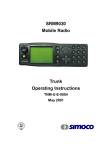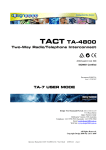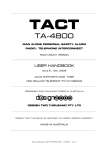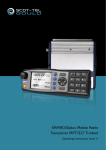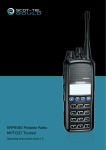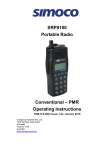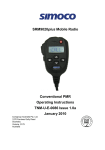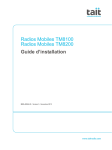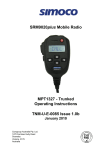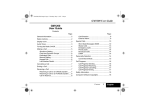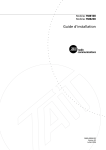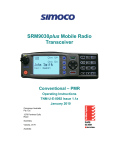Download Desighn2000 TACT TA-4800 Specifications
Transcript
________________________________________________________________________________________________ _________________________________________________________________________________________________ TACT TA-4800T TRUNKED TWO-WAY RADIO / TELEPHONE INTERCONNECT RACK MOUNT / DESK-TOP VERSION ACMA SUPPLIER’S CODE N468 NEW ZEALAND TELEPERMIT PTC 210/96/003 ________________________________________________________________________________________________ USER HANDBOOK Issue 6, OCTOBER, 2008 ________________________________________________________________________________________________ DESIGNED AND MANUFACTURED TO QA STANDARD ISO9001 BY DESIGN TWO THOUSAND PTY LTD ________________________________________________________________________________________________ MADE IN AUSTRALIA __________________________________________________________________________________________________________ Operator Handbook for TACT TA-4800T G/01142 Issue 6 ________________________________________________________________________________________________ __________________________________________________________________________________________________________ Operator Handbook for TACT TA-4800T G/01142 Issue 6 ________________________________________________________________________________________________ Document Control Document ID Document Name Security Circulation T/01142 TACT TA-4800T Handbook Commercial In Confidence Design 2000 Pty. Ltd., Authorised Distributors Prepared By P. Zeug Reviewed By R. Kells Approved By Version Control Edition Date Notes 3 20/09/2006 Includes TM8000 Series information 4 5 6 11/10/2006 19/07/2007 14/10/2008 Formatting improvements MCX780 Information SRM9000 Information __________________________________________________________________________________________________________ Operator Handbook for TACT TA-4800T G/01142 Issue 6 14/10/2008 G/01142 TACT TA-4800T Handbook Issue 6 TACT TA-4800T MPT1327 TRUNKED MOBILE RADIO/TELEPHONE INTERCONNECT USER HANDBOOK SECTION CONTENTS 1 1.1 Introduction Standard Features 1 1 2 2.1 2.2 Installation Brief Connecting TACT to the Telephone Line & to the Base Radio Connection Diagram 2 3 3.1 3.2 User Instructions Calling a Radio from a Telephone Calling a Telephone from a Radio 3 3 4.1 4.2 4.3 4.4 4.5 4.6 4.7 4.7.1-3 4.8 4.9 4.10 Programming Options & Features Speed Dialing Exchange line Access from a PABX Type of Dialing Number Of Radio Identity Digits (Two Or Three Digit Identity) Automatic Dialing of a Telephone Number Automatic Diversion to a Mobile Call Clear Down and Follow-on Calls Automatic, Manual & Forced Disconnect Voice Prompts Status Call Programming Summary 5 5 5 6 6 6 7 7 7 7 8 Installation Details TACT Connectors T2000 Series Information T2000 Radio Internal Wiring for Tx and Rx audio T2000 Interface Cable (supplied) T8000 Series Information T8000 Interface Cable Pin-outs T8000 Auxiliary Connector Motorola MCX780 Interface Cable Simoco SRM9000 Interface Cable 9 12 12 13 14 14 14 15 16 Speed Dial Programming Record 18 Appendix 1 - Network Call Set Up Mode Appendix 2 - Call Logging Facility Appendix 3 - Group Call Handling Appendix 4 - Call Establishment Using a PC 19 19 20 20 Specifications 22 3 4 5 5.1 5.2 5.2.1 5.2.2 5.3 5.3.1 5.3.2 5.4 5.5 6 A1 A2 A3 A4 7 PAGE ___________________________________________________________________________________________________________ Operator Handbook for TACT TA-4800T G/01142 Issue 6 G/01142 14/10/2008 TACT TA-4800T Handbook Issue 6 DESIGNED & MANUFACTURED BY DESIGN TWO THOUSAND PTY LTD www.design2000.com.au [email protected] AUSTRALIAN OFFICE Design 2000 Pty Ltd 9-11 Rose Street Upper Ferntree Gully Melbourne Victoria 3156 Australia Sales Contact: +61 3 9758 5933 +61 3 9758 5560 N468 ___________________________________________________________________________________________________________ Operator Handbook for TACT TA-4800T G/01142 Issue 6 19/07/2007 G/01142 TACT TA-4800T Handbook Issue 6 TACT TA-4800T 1. INTRODUCTION TACT, the Telephone Access Control Terminal, interfaces an MPT 1327 Trunking RF Control Base (Fixed Mobile) to any PABX/Key System internal analogue extension, or direct PSTN line. Dual Tone Multi-Frequency (DTMF) is used to initiate calls both to and from mobiles: Any mobile on the trunked system can call any telephone, using a DTMF microphone. Similarly, any DTMF dialing telephone can selectively call any mobile. 1.1 STANDARD FEATURES Voice prompts and responses make the system easy and straightforward to use. DTMF dialing. Call barring - programmable to enable/disable outside and long distance calls. Speed dialing of up to ninety-nine user pre-programmed telephone numbers. Last number redial. Automatic dialing of first Speed Dial number if mobile does not have a DTMF microphone. Audio buffer (digital delay) so that the beginning of sentences are not missed. Local Keypad programming. Full remote control. All service tone detection parameters, timers, and VOX timers and sensitivity are remotely programmable. Serial Interface. Standard interconnecting cable between RF control base radio and TACT (supplied). Calling party control of call connection/disconnection. Visual indicators include POWER (dc power on), Tx (PTT), Rx (Receive AF), CONNECT (Line seized), ON AIR (Radio connected), READY LEDs and a seven segment display. MAP 27 Interface (full implementation). 1RU, 19” rack mount (can also be put in a shelf or on a desk) Call logging facility (optional). Bilingual voice prompts (optional). ___________________________________________________________________________________________________________ Operator Handbook for TACT TA-4800T G/01142 Issue 6 Page 1 14/10/2008 G/01142 TACT TA-4800T Handbook Issue 6 2. INSTALLATION BRIEF For more detail, please refer to Installation Details. 2.1 CONNECTING TACT TO THE TELEPHONE LINE & TO THE BASE RADIO TACT is connected to the PABX internal analogue extension or direct PSTN line using the RJ12 line cord provided. The RJ12 end is plugged into the socket at the back of TACT marked ‘LINE 1'. The 605 end (other plugs to order) is plugged into a working telephone socket. When connecting TACT to a PABX internal analogue extension, this extension can be programmed to ‘ring' when a designated exchange line number is called. This provides field access for callers calling in from any internal extension and/or from any outside line. 2.2 CONNECTING TACT TO THE BASE RADIO TACT is connected to the Base Radio using the Interconnecting cable supplied. For certain radio specific applications, a special cable will need to be custom made. If you are using a TAIT or SIMOCO radio, the base microphone, which must be a standard Mic (not a controller Mic), may also be plugged into the ‘MIC’ socket at the rear of TACT. Calling mobiles from the base is then possible using the TACT keypad. In the case of SIMOCO PMR 80 radios, the Base Radio must be programmed for ‘Partial Off Air Mode’ (POACSU), for use with a ‘Controller Mic’, NO ‘DTMF Overdial’ and not to respond to ‘Group Call’. If you are using a TAIT, MOTOROLA, SIMOCO SRM9000 or NOKIA radio, it must have the MAP 27 Interface. The full MAP27 protocol is supported by TACT. Out-of-the-box, TACT supports RS232 data levels but it can be internally jumpered for TTL data levels (please note that RS232 mark/spaces are inverted when compared to TTL mark/spaces). TACT is powered by a 12Vdc 750mA power adaptor, or from the radio power supply unit where allowable. ___________________________________________________________________________________________________________ Operator Handbook for TACT TA-4800T G/01142 Issue 6 Page 2 14/10/2008 G/01142 TACT TA-4800T Handbook Issue 6 2.3 CONNECTION DIAGRAM WIND SPEED RADIO WATER LEVEL TEMPERATURE DC POWER BATTERY VOLTS MIC ALARM INPUT CABINET TEMP ETC ALARM & AUX RELAY RELAY 1 OUT RELAY 2 OUT RS232 TELEMETRY I/F RADIO/TELEPHONE INTERCONNECT LINE 1 LINE 2 ALARM MIC RADIO RS232 PC MODEM POWER 12-48V DC POLARITY INSENSITIVE SERIAL No. Rear View ACA SUPPLIER’S CODE N468 POWER 12 - 48V DC RS232 LINE PSTN OR PABX 4 * 0 TELEPHONE 4 MOBILE TELEPHONE Front View CONNECT Tx POWER ON AIR Rx READY ___________________________________________________________________________________________________________ Operator Handbook for TACT TA-4800T G/01142 Issue 6 Page 3 14/10/2008 G/01142 TACT TA-4800T Handbook Issue 6 3. USER INSTRUCTIONS 3.1 CALLING A TELEPHONE FROM A RADIO Mobiles not already fitted with a DTMF dialing microphone will need to have one fitted in order to make selective telephone calls. 1. 2. 3. 4. 5. 6. Call the base radio and listen for "Enter telephone number followed by hash (#)". Dial the desired telephone number followed by #. If you make a mistake, press star (*) and start again. Listen for the normal ring tones etc. When the telephone party answers, proceed with conversation. To end the call, press the ‘CALL’ button on the front of the radio or simply replace the Mic on the cradle. 3.2 CALLING A RADIO FROM A TELEPHONE Telephones used to call mobiles will need to have DTMF dialing capability. Portable DTMF Encoders or ‘Pocket Tone dialers’ may be used if the telephone does not dial DTMF. 1. 2. 3. 4. 5. 6. Dial the internal extension number or the exchange line number of TACT. Listen for "Enter mobile number followed by hash". Dial the two or three digit mobile number you wish to call followed by hash. Listen for the Trunked System's call progress tones. When the mobile answers, proceed with conversation. To end the call, either: i) Simply hang up, or: ii) Press *# and then dial another mobile number. ___________________________________________________________________________________________________________ Operator Handbook for TACT TA-4800T G/01142 Issue 6 Page 4 14/10/2008 G/01142 TACT TA-4800T Handbook Issue 6 4. PROGRAMMING OPTIONS & FEATURES All user programmed data, system options and tone detection parameters can be verified or changed via the inbuilt Keypad. Remote programming is also possible from any DTMF Telephone. Simply dial up TACT and wait for answer. Then enter *671234# and listen for “Please enter command”. You can now program as normal. Data retained in memory (EEPROM) can also be interrogated and altered remotely at higher speed when TACT is accessed by the central control computer at Entropia. 4.1 SPEED DIALING Abbreviated (or speed) dialing of up to 99 of your most frequently called telephone numbers. 4.1.1 1. 2. 3. 4. 5. 6. From the TACT Keypad, press *2. Enter the required memory location xx, where xx = 00 99 Enter the required telephone number (up to twenty digits). Press #. The number will be displayed for confirmation. Note the number down in the MEMORY DIAL INDEX (last page). To check the number in memory, press *2xx#, where xx is the memory location. 4.1.2 1. 2. 3. 4. To Store Speed Dial Numbers To Call Speed Dial Numbers Call the base radio and listen for "Enter telephone number followed by hash (#)". Press #. Enter required memory location (00 -99). You will hear the number being dialed. Proceed with the call. 4.1.3 Last Number Redial 1. Call the base radio and listen for "Enter number followed by hash (#)". 2. Press # #. You will hear the number being dialed. 3. Proceed with the call. 4.2 EXCHANGE LINE ACCESS FROM A PABX TACT can automatically insert a two second dialing pause after the first digit. This allows time for the second (exchange) dial tone to be obtained before TACT dials the outside number. From the Keypad of TACT: 1. Press * 6703# 2. Press *06 3. Press 0 for no dialing pause after first digit, or 1 for a dialing pause after first digit. 4. Press *#. 4.3 TYPE OF DIALING (DTMF) There are two types of dialing modes commonly used. Either DTMF (‘Touch Tone’) or DECADIC (Pulse). Most telephone systems accept DTMF dialing, which is faster, so this is the default dialing mode for TACT. ___________________________________________________________________________________________________________ Operator Handbook for TACT TA-4800T G/01142 Issue 6 Page 5 14/10/2008 G/01142 TACT TA-4800T Handbook Issue 6 4.4 NUMBER OF RADIO IDENTITY DIGITS (TWO OR THREE DIGIT IDENTITY) Many fleets have radios with a two or three digit identity. When calling a radio from a telephone, you are asked by TACT to "Enter Radio Number followed by hash". Many telephone users however are not familiar with the term hash (#). TACT may be programmed to accept a two or three digit radio identity and then immediately dial the inputted number. Telephone users are then not required to enter hash (#) after the radio number. From the Keypad of TACT: 5. Press * 6703# 6. Press *35. TACT reads back the current setting eg. 00 (no limit). 7. Press 02 for two radio ID digits or 03 for three radio ID digits. TACT reads back 02 or 03. 8. Press *# to save the change. Notes: I. If it is required to make inter-fleet calls from the telephone, do not program the number of radio digits to less than seven (07). 4.5 AUTOMATIC DIALING OF A TELEPHONE NUMBER If mobiles are not fitted with DTMF dialing microphones, it is possible for TACT to automatically dial a preprogrammed when a call is received from the radio. The mobile user calls the base radio and receives ring tone while TACT dials the pre-programmed phone number. To Program Automatic Dialing of a Telephone Number From the Keypad of TACT: 1. Press * 85 nnn…#, where nnn… is the telephone number to be dialed automatically on receipt of a radio call. 2. Press * 85 0 # to turn this option off. 4.6 AUTOMATIC DIVERSION TO A MOBILE This mode is used to automatically divert incoming telephone calls to a mobile radio. When an incoming telephone call is received, TACT dials the mobile number stored in memory as programmed below. Callers into TACT will hear normal ringing tone until the call is answered at the mobile. To Activate Diversion Facility to a Mobile: From the Keypad of TACT: 1. Press * 86 nn…#, where nn…# is the mobile number to which telephone calls will be diverted. 2. Press * 86 0 # to turn this option off. ___________________________________________________________________________________________________________ Operator Handbook for TACT TA-4800T G/01142 Issue 6 Page 6 14/10/2008 G/01142 TACT TA-4800T Handbook Issue 6 4.7 CALL CLEAR DOWN AND FOLLOW-ON CALLS 4.7.1 Automatic Disconnect The TACT TA-4800T will automatically disconnect a call when busy tone, dial tone, number unobtainable tone, line reversal or line loop current loss is detected on the telephone line. 4.7.2 Manual Clear Down and Follow-on Calls In addition to the automatic call disconnect, there is a manual radio ‘clear down’ command: *#. (This works only from the telephone end to clear down the radio). This enables the telephone party to make a ‘Follow-on’ call without having to redial TACT each time consecutive calls to mobiles need to be made. When a mobile is called from a telephone, and the mobile is not answering, you may press *# and then dial the same or another mobile. This may be continued until an answer is found, or when the telephone is hung up. Similarly, if a mobile ‘rings out’, you will hear "Mobile unattended" at which time you can press *# and dial the same or another mobile. If you are on a call to a mobile and wish to dial another mobile, simply press *# (before or within 4 seconds of the mobile hanging up otherwise the connection will be lost), and dial another mobile. 4.7.3 Forced Disconnect Please note that if you wish to force both the radio and telephone line to immediately disconnect without a follow-on call, press *# on the telephone or radio and just hang up. 4.8 VOICE PROMPTS The TA-4800T guides the user with voice prompts and responses such as "Enter telephone number followed by hash", and "Thank you ... " etc. to confirm operating progress. 4.9 STATUS CALL When calling an unattended mobile, it is possible for the telephone party to leave a status message. When the person returns to the mobile, the status message may be used to identify the calling party so that the call can be returned. The status message may simply be the last two digits of the extension number, some other two digit code for Calling Line Identification (CLI), or a normal status message. To Leave a Status Message: Mobile is not answering or did not answer: 1. Press * # (within four seconds). You will hear "Enter mobile number followed by hash". 2. Press * 0 nn * mm... #, where nn = 1-9, 10-30 (status message) and mm… = mobile number to receive status message. No attempt is made to actually call mobile, just leave status message: 1. Call the base radio and listen for "Enter mobile number followed by hash (#)". 2. Press * 0 nn * mm... #, where nn = 1-9, 10-30 (status message) and mm... = mobile number. ___________________________________________________________________________________________________________ Operator Handbook for TACT TA-4800T G/01142 Issue 6 Page 7 14/10/2008 G/01142 TACT TA-4800T Handbook Issue 6 4.10 PROGRAMMING SUMMARY CODE FUNCTION FROM nn... # nn... # *2xx nn...# *2xx# # xx ## *# ## * 0 nn * mm... # * 06 0 *# * 06 1 *# * 85 0 # * 85 nnn…# * 86 0 # * 86 nn…# * 48 # *671234# * 67 7096 01 # * 67 7096 30 # Call Radio from Telephone Call Telephone from Radio Store Speed Dial Number Check Speed Dial Number Call Speed Dial Number Last Number Redial Follow-on Call Immediate disconnect Status Call No dialing pause after first digit Dialing pause after first digit No Automatic Dialing of phone number Automatic Dialing of phone number nnn… Turn off Diversion to a Mobile Turn on Diversion to Mobile nn… EPROM Version Number Access Remote Programming mode Master Reset - System Master Reset – Speed Call Numbers Telephone Radio Keypad Keypad Radio Radio Telephone Telephone or radio Telephone Keypad Keypad Keypad Keypad Keypad Keypad Keypad Radio Keypad (CAUTION) Keypad (CAUTION) Note: Master Resets erase all customer programmed data and reset the TACT unit to the factory default condition. TA-4800T Firmware Storage Medium System Number Speech Number EPROM V4833vv V4901vv ___________________________________________________________________________________________________________ Operator Handbook for TACT TA-4800T G/01142 Issue 6 Page 8 14/10/2008 G/01142 TACT TA-4800T Handbook Issue 6 5. INSTALLATION DETAILS 5.1 TACT CONNECTORS 5.1.1 RADIO The radio interface connection PIN 1 2 3 4 5 6 7 8 5.1.2 DESCRIPTION PTT Common PTT Normally Open MAP 27 (Digital) Out COS Indication from Radio MAP 27 (Digital) In Signal Ground (Return) (OV) Tx Audio Out from TACT to Radio Rx Audio In to TACT from Radio TELEPHONE LINE 1 PSTN line or PABX extension connection PIN 1 2 3 4 5 6 DESCRIPTION Ring (Lb) Tip (La) LINE 2 Not used in MPT mode. PIN 1 2 3 4 5 6 DESCRIPTION Ring (Lb) Tip (La) ___________________________________________________________________________________________________________ Operator Handbook for TACT TA-4800T G/01142 Issue 6 Page 9 14/10/2008 G/01142 TACT TA-4800T Handbook Issue 6 5.1.3 ALARM INPUT & AUXILIARY OUTPUT RELAYS For the OPTIONAL connection of an external alarm system. A contact closure fires off the TACT alarm dialer and the Alarm message to air. Two Auxiliary output relays are also provided to trigger external devices. The output relays are controlled from the telephone or radio using DTMF. PIN 1 2 3 4 5 6 7 8 DESCRIPTION Relay 1 Normally Open Relay 1 Common Relay 1 Normally Closed Alarm In Ground Relay 2 Normally Open Relay 2 Common Relay 2 Normally Closed 5.1.4 PC RS232 (Configured as DCE) RS232 Serial COM port for a PC. Used at the factory for diagnostic purposes and reserved for future custom applications such as call logging. PIN 1 2 3 4 5 6 7 8 DESCRIPTION CD (Common to Modem) RI (Common to Modem) RXD (Data received by PC) DTR (Common to Modem) TXD (Data Transmitted by PC) Ground RTS (Common to Modem) CTS (Common to Modem) 5.1.5 MODEM RS232 (Configured as DCE) RS232 Serial COM port for a modem. Reserved for future custom applications possibly involving a modem controlled by the PC. PIN 1 2 3 4 5 6 7 8 DESCRIPTION CD (Common to PC) RI (Common to PC) RXD (Data received by Modem) DTR (Common to PC) TXD (Data Transmitted by Modem) Ground RTS (Common to PC) CTS (Common to PC) ___________________________________________________________________________________________________________ Operator Handbook for TACT TA-4800T G/01142 Issue 6 Page 10 14/10/2008 G/01142 TACT TA-4800T Handbook Issue 6 5.1.6 MIC This is an auxiliary audio I/O accessory connector. It’s most common use is to monitor both-way audio via a set of self-powered PC type speakers. PIN 1 2 3 4 5 6 7 8 DESCRIPTION Relay Common contact Relay Normally Open contact Ground Audio out for recording Audio in from a microphone 5.1.7 POWER For power input connection, usually 13.8 Vdc nominal. PIN 1, 2 DESCRIPTION 12 48 Vdc, isolated, polarity insensitive ___________________________________________________________________________________________________________ Operator Handbook for TACT TA-4800T G/01142 Issue 6 Page 11 14/10/2008 G/01142 TACT TA-4800T Handbook Issue 6 5.2 TAIT T2000 SERIES INFORMATION 5.2.1 RADIO INTERNAL WIRING (TAIT T2000 SERIES WITHOUT DUAL UART) The TAIT T2000 Series dual UART option is the preferred interconnection method. If this is not available, then Tx and Rx audio does not normally appear on the TAIT facility connector. It must be connected to pins 6 and 1 as shown here. Modifications for TAIT T2000 for use with TA-4800 Trunked TACT The TAIT T2000 must have a T2000 A66 Single Port UART Fitted according to TAIT’s Instructions Additionally there are two connections that need to be made between the data interface decoupling PCB (DB9) and the T2000 enhanced logic PCB (board that the UART board is fitted to) Pin 1 Connection These additional connections provide Tx and RX Audio for connection to the TA-4800. Pin 6 Connection FACILITY CONNECTOR (Data Interface Decoupling PCB) Shown installed (with Ribbon cable disconnected) S13 Connector connect pin 6 on Facility Connector DB9 (Audio in) to pin 6 on this connector S9 Connector connect pin 1 on Facility Connector DB9 (Audio out) to pin 6 on this connector T2000-A66 UART PCB Shown as installed ___________________________________________________________________________________________________________ Operator Handbook for TACT TA-4800T G/01142 Issue 6 Page 12 14/10/2008 G/01142 TACT TA-4800T Handbook Issue 6 5.2.2 INTERFACE CABLE FOR T2000 SERIES RADIOS FITTED WITH SINGLE UART ONLY T2000 to TA-4800 Trunked TACT Interface Cable Details 1 6 2 7 3 8 4 9 5 8 1 SK1 DB9 Male Viewed from wiring side PL1 RJ45 Plug Viewed with tab on top FACILITY CONNECTOR To T2000 TAIT Radio with T2000-A66 Single UART and T2000-A50 NOT fitted RADIO CONNECTOR To TA-4800 PIN 1 2 3 4 5 6 7 8 9 PIN 1 2 3 4 5 6 7 8 DESCRIPTION AUDIO OUT FROM RADIO TXD (data out from radio) RXD (data into radio) Not Connected DGND AUDIO INTO RADIO Not Connected Not Connected Not Connected DESCRIPTION PTT COMMON PTT NORMALLY OPEN MAP27 (DIGITAL) OUT COS MAP27 (DIGITAL) IN GROUND RADIO AUDIO OUT FROM TACT (TX) RADIO AUDIO INTO TACT (RX) REF: CA-4903 REV2 ___________________________________________________________________________________________________________ Operator Handbook for TACT TA-4800T G/01142 Issue 6 Page 13 14/10/2008 G/01142 TACT TA-4800T Handbook Issue 6 5.3 TAIT T8000 SERIES INFORMATION The TAIT TM8255 is an extremely flexible radio with many programmable options and audio tap points. At the time of writing here are our suggestions only as a starting point when connecting the T8255 radio to TACT. Please use the FULL MAP27 implementation. You may also need to insert links 12, 13 & 14 in TACT to obtain TTL levels (note that this also inverts the logic sense) if the standard TACT RS232 levels fail to operate. 5.3.1 T8000 INTERFACE CABLE PIN-OUTS TM8255 AUX_TxD AUX_RxD AUD_TAP_IN, Audio in (Rx) AUD_TAP_OUT, Audio Out (Tx) +13.8V Ground 5.3.2 TAP POINT DB15 Pin R10 T5 - 11 3 7 13 8 - 15 TACT TA-4800T MAP27 RxD MAP27 TxD Audio Out (Tx) Audio In (Rx) Power (may be wired to the BL power connector) Ground (may also be wired to the BL power connector) RJ-45 Pin 5 3 7 8 6 T8000 AUXILIARY CONNECTOR – PINS & SIGNALS ___________________________________________________________________________________________________________ Operator Handbook for TACT TA-4800T G/01142 Issue 6 Page 14 G/01142 14/10/2008 TACT TA-4800T Handbook Issue 6 5.4 MOTOROLA MCX780 INTERFACE CABLE NOTES: The MAP27 Control Head (GCN6118A) is fitted. The baseline firmware version is R04.01.02 or later. ___________________________________________________________________________________________________________ Operator Handbook for TACT TA-4800T G/01142 Issue 6 Page 15 G/01142 14/10/2008 TACT TA-4800T Handbook Issue 6 5.5 SIMOCO SRM9000 INTERFACE CABLE NOTES: At the time of writing, information on the SRM9000 MAP27 interface was sketchy. Design 2000 was able to successfully interface the TACT to the SRM9000 using the Simoco MA-ASIG option board. At the time of writing, the SRM9000 Radio Control Port defaulted to 19,200 baud, 8N1 format, TTL levels (0-5V) with inverted logic. The optional RS232 board (Simoco option board MA-ASIG) was required for 9600 baud, 8N1 format, RS-232 levels (± 12V nom.). It was also noted that the Option PTT audio path was operational in PMR mode but NOT in trunking mode. This may have since been incorporated. As specified in the UADG MAP27 Protocol Version 1.2 or later, ensure that the SRM9000 is configured for RS232 levels and that the baud rate is set to 9600 baud as extracted here: As the Option PTT audio path is not operational in trunking mode, it is necessary to make up a ‘Y’ interface cable that routes audio via the radio control port as sketched here: ___________________________________________________________________________________________________________ Operator Handbook for TACT TA-4800T G/01142 Issue 6 Page 16 G/01142 14/10/2008 TACT TA-4800T Handbook Issue 6 Using the SRM9000 Programming Cable with the inbuilt level converter, it is in theory possible to interface the TACT to the SRM9000 as follows but this had not been tested at the time of writing. PIN 1 2 3 4 5 6 7 8 SRM9000 Control Port ASSIGNMENT RxD (Data FROM Radio to TACT) TxD (Data TO Radio from TACT) NC (On/Off) MIC Ground NC (SW Out) Radio Handset Audio OUT to TACT Ground MIC Audio IN from TACT PIN 5 3 TA-4800 Radio Connector DESCRIPTION MAP 27 (Digital) IN MAP 27 (Digital) OUT 8 6 7 Rx Audio IN to TACT from Radio Signal Ground (Return) (OV) Tx Audio OUT from TACT to Radio ___________________________________________________________________________________________________________ Operator Handbook for TACT TA-4800T G/01142 Issue 6 Page 17 14/10/2008 G/01142 TACT TA-4800T Handbook Issue 6 6. PROGRAMMING RECORD 6.1 SPEED DIAL INDEX MEMORY NAME NUMBER # 00 _________________ # 01 _________________ # 02 _________________ # 03 _________________ # 04 _________________ # 05 _________________ # 06 _________________ # 07 _________________ # 08 _________________ # 09 _________________ # 10 _________________ # 11 _________________ # 12 _________________ # 13 _________________ # 14 _________________ # 15 _________________ # 16 _________________ # 17 _________________ # 18 _________________ # 19 _________________ # 20 _________________ # 21 _________________ # 22 _________________ # 23 _________________ # 24 _________________ # 25 _________________ # 26 _________________ # 27 _________________ # 28 _________________ # 29 _________________ # 30 _________________ # 31 _________________ # 32 _________________ # 33 _________________ # 34 _________________ # 35 _________________ # 36 _________________ # 37 _________________ # 38 _________________ # 39 _________________ # 40 _________________ # 41 _________________ # 42 _________________ # 43 _________________ # 44 _________________ # 45 _________________ # 46 _________________ # 47 _________________ # 48 _________________ # 49 _________________ ## Last Number Redial __________________ __________________ __________________ __________________ __________________ __________________ __________________ __________________ __________________ __________________ __________________ __________________ __________________ __________________ __________________ __________________ __________________ __________________ __________________ __________________ __________________ __________________ __________________ __________________ __________________ __________________ __________________ __________________ __________________ __________________ __________________ __________________ __________________ __________________ __________________ __________________ __________________ __________________ __________________ __________________ __________________ __________________ __________________ __________________ __________________ __________________ __________________ __________________ __________________ __________________ TO STORE NUMBER: TO SPEED DIAL NUMBER: MEMORY NAME Press *2 xx nnnn nnnn # Press # xx NUMBER # 50 _________________ # 51 _________________ # 52 _________________ # 53 _________________ # 54 _________________ # 55 _________________ # 56 _________________ # 57 _________________ # 58 _________________ # 59 _________________ # 60 _________________ # 61 _________________ # 62 _________________ # 63 _________________ # 64 _________________ # 65 _________________ # 66 _________________ # 67 _________________ # 68 _________________ # 69 _________________ # 70 _________________ # 71 _________________ # 72 _________________ # 73 _________________ # 74 _________________ # 75 _________________ # 76 _________________ # 77 _________________ # 78 _________________ # 79 _________________ # 80 _________________ # 81 _________________ # 82 _________________ # 83 _________________ # 84 _________________ # 85 _________________ # 86 _________________ # 87 _________________ # 88 _________________ # 89 _________________ # 90 _________________ # 91 _________________ # 92 _________________ # 93 _________________ # 94 _________________ # 95 _________________ # 96 _________________ # 97 _________________ # 98 _________________ # 99 _________________ __________________ __________________ __________________ __________________ __________________ __________________ __________________ __________________ __________________ __________________ __________________ __________________ __________________ __________________ __________________ __________________ __________________ __________________ __________________ __________________ __________________ __________________ __________________ __________________ __________________ __________________ __________________ __________________ __________________ __________________ __________________ __________________ __________________ __________________ __________________ __________________ __________________ __________________ __________________ __________________ __________________ __________________ __________________ __________________ __________________ __________________ __________________ __________________ __________________ __________________ TO CANCEL STORED NUMBER: Press *2 xx 0 # ___________________________________________________________________________________________________________ Operator Handbook for TACT TA-4800T G/01142 Issue 6 Page 18 14/10/2008 G/01142 TACT TA-4800T Handbook Issue 6 APPENDIX 1 - NETWORK CALL SET UP MODE The way in which calls are set up in an MPT 1327 Trunked Radio Network can vary depending on the particular network. This is referred to as the "Off Air Call Set Up (OACSU)" mode. It may be in the form of Full Off Air Call Set Up (FOACSU) or Partial Off Air Call Set Up (POACSU). If the Network is set for FOACSU (also referred to as manual answer), incoming calls are manually answered by TACT and then connected, ie. Network requires incoming call answer for call to be connected. A radio enabled for full off-air call setup functions more like a phone. The called radio rings until the user presses the PTT. Likewise, the user of the calling radio, if enabled for full off-air call setup, hears ringing until the user of the called radio answers. If the Network is set for POACSU (also referred to as automatic answer), incoming calls are automatically connected, ie. Network connects incoming call immediately. The system checks to see if the unit being called is in radio contact, before allocating a traffic channel for the call. No check is made to see if you can/want to accept the call. All MAP 27 compliant TACT units automatically adapt to either FOACSU or POACSU. APPENDIX 2 - CALL LOGGING FACILITY (OPTIONAL) All MAP 27 TACT units have a factory fitted option of providing caller or called party radio identification, global position (if fitted in vehicle), set up direction (phone to radio, radio to phone), telephone number dialed, call end and call duration. This information is provided on a second RS 232 port - an optionally fitted DB 9 connector on the back panel of TACT marked "CALL DATA". Call logging information (in ASCII) is sent to a Personal Computer where it can be directly displayed and/or processed as required. TACT is capable of generating several Log numbering formats for call identification, the format of which must be selected to suit. From the keypad of TACT: To Select MPT 1327 Log Numbering Format (Default): Press * 63 0 #. To Select MPT 1343 Log Numbering Format: Press * 63 1 #. To Select Short form Log Numbering Format: Press * 63 2 #. To Select No Numbering Information: Press * 63 3 #. ___________________________________________________________________________________________________________ Operator Handbook for TACT TA-4800T G/01142 Issue 6 Page 19 14/10/2008 G/01142 TACT TA-4800T Handbook Issue 6 APPENDIX 3 - GROUP CALL HANDLING All MAP 27 TACT units may be connected to a ‘fixed’ mobile that is programmed to respond to group calls. There are several ways that TACT can handle a group call. By default, TACT makes the radio ignore group calls so that it doesn’t interfere. 1. Group Call ‘Ignore’ TACT denies telephone access to a group call. Any person dialing the TACT during a group call will receive a message "Call in progress, try again shortly". APPENDIX 4 - CALL ESTABLISHMENT USING A PERSONAL COMPUTER A4.1 Description If your TACT is fitted with the serial port used for the optional Call Logging Facility described in Appendix 2, then a PC may be used to establish calls requested by either a phone caller or a mobile radio caller. In addition, the PC can unconditionally disconnect any established call. The interconnect should be programmed to the Off state. This allows the PC to take charge of call establishment rather than the radio or telephone user. An operator located near the base radio answers radio or telephone calls, and places calls to the requested party, using a computer connected to TACT’s serial port. Typically the commands issued by the computer would be generated by suitable software accessing a data base of stored numbers, with provision for manually entering a mobile or telephone number. If required, this PC software is provided by you. A4.2 Connection Your computer’s serial port can be connected with a simple three wire connection, Tx, Rx and Ground. The TACT’s standard serial port uses a 9 pin connector configured as Data Communication Equipment (DCE). Direct connection is required if the PC’s serial port is a Data Terminating Equipment (DTE), which is the standard for IBM compatible COM ports. A null modem cable should be used if the PC uses a DCE connection, and a 9 pin to 25 pin adaptor if required. The PC port must be set up for 9600 baud, 8 bits, no parity and one stop bit. ___________________________________________________________________________________________________________ Operator Handbook for TACT TA-4800T G/01142 Issue 6 Page 20 14/10/2008 G/01142 TACT TA-4800T Handbook Issue 6 A4.3 Commands Three ASCII commands are available, which are not echoed back to the PC: A4.3.1 Call Mobile The command is: MOBILEnnnnnn# Loop telephone line. Call mobile nnnnnn and pass control to TACT. At the end of the call TACT returns an idle state. Call logging described in Appendix 2 shows the set up and end of the call Short form numbers and interfleet calls using MPT1343 format are currently supported. A4.3.2 Call Telephone The command is: PHONEnnnnnn# Loop telephone and dial telephone number. Pass control to TACT as before. A4.3.3 Unconditionally hangup The command is: HANGUP# Unconditionally disconnect both phone and radio. A4.4 Possible Developments Software Version 4833 or later of this facility provides for operator intervention for calls in both directions: radio-to-telephone and telephone-to-radio. If required, future development could provide for a programmable option to select: 1. Operator intervention in either direction or both. 2. A programmed time during which calls could be intercepted by the operator, after which normal entering of the number would take place from telephone or radio. If you require either of these enhancements, or any others, please discuss your requirements with Entropia. ___________________________________________________________________________________________________________ Operator Handbook for TACT TA-4800T G/01142 Issue 6 Page 21 14/10/2008 G/01142 TACT TA-4800T Handbook Issue 6 7. SPECIFICATIONS Enclosure Finish Power Requirement Power Consumption Initial Start-up Current Operating Temperature Range Storage Temperature Range Humidity, Storage and Operating Mean Time Between Failure: TACT Radio Interface (PMR) IN OUT COS detect PTT TACT Radio Interface (MAP27) Audio Input level Audio Output level Frequency range Telephone Line Interface Ringer Equivalent Number (REN) Ring Detect Answer Delay In-band Signalling DTMF Dialler DTMF Receiver 5 Tone Paging Protocol (PMR) Keypad Displays RS232 Port Telephone Service Tone detection ACA Supplier Code Number Warranty Firmware Storage Medium System Number Speech Number 1RU high, 19” rack mount, 250mm deep. Dulux metallic black onyx pearl powder coat. 12 48 Vdc nominal, polarity and ground insensitive. 65 mA @ 48 V 135 mA @ 24 V 300 mA @ 12 V ie. 3.2 W nominal @ 48V 300 mA for 40 ms @ 48 V 500 mA for 50 ms @ 24 V 750 mA for 90 ms @ 12 V -10 +60 C. -20 80 C ambient. To 98% non condensing. > 20 years. 10K Ohm input impedance. Strappable 600 Ohm termination. 600 Ohm output impedance. High impedance input, floating to +5V, grounded by radio to indicate COS (inverted sense programmable). Relay contact, switching to ground for PTT activation. Mobile Access Protocol 27, full implementation. -30 +6 dBm adjustable (-13.5 dBm nom.). -30 +6 dBm adjustable. (-13.5 dBm nom.). 300 Hz 5 kHz. Standard two wire analogue ring in/loop out. 0.5. 10V RMS @ 13-55 Hz (25 Hz nominal), 100 ms. 100 ms. Dual Tone Multi Frequency (DTMF). 100 ms on/off, -10dBm. -40 0 dBm sensitivity. CCIR 40 ms. 12 push button 4 x 3 numeric silicone membrane keypad. 7 segment numeric readout, 6 x status LEDs. 9600 baud, 8N1 format. -30 dBm sensitivity, automatic cadence detection. N468. Two years EPROM V4833 31 or later V4901 02 or later (English) V4902 01 or later (Spanish) ___________________________________________________________________________________________________________ Operator Handbook for TACT TA-4800T G/01142 Issue 6 Page 22 G/01142 14/10/2008 TACT TA-4800T Handbook Issue 6 TACT TA-4800T MPT1327 TRUNKED MOBILE RADIO/TELEPHONE INTERCONNECT DESIGNED & MANUFACTURED BY DESIGN TWO THOUSAND PTY LTD www.design2000.com.au [email protected] AUSTRALIAN OFFICE Design 2000 Pty Ltd 9-11 Rose Street Upper Ferntree Gully Melbourne Victoria 3156 Australia Sales Contact: +61 3 9758 5933 +61 3 9758 5560 N468 ___________________________________________________________________________________________________________ Operator Handbook for TACT TA-4800T G/01142 Issue 6 Page 23




























